
Concept explainers
For theseries-parallel network in Fig.17.38.
a. Calculate ZT.
b. Determine Is.
c. Determine I1.
d. Find I2.
e. Find VL..
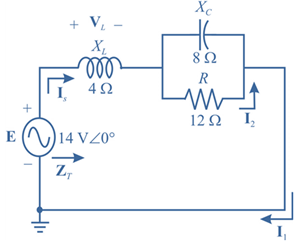
Fig.17.38
(a)
Total impedance
Answer to Problem 1P
Explanation of Solution
Given:
The given circuit is:

Calculation:
Let us modify the circuit as below to calculate the total impedance.
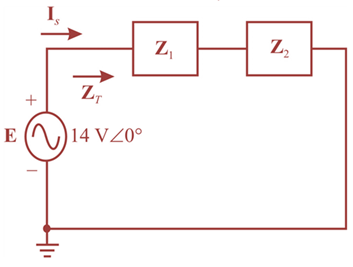
In the modified diagram,
Impedance
Impedance
Therefore, total impedance will be:
Putting the values for the total impedance:
(b)
The current
Answer to Problem 1P
Explanation of Solution
Given:
The given circuit is:
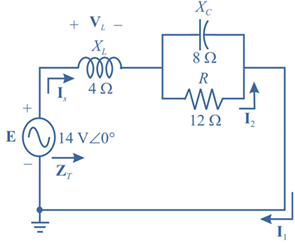
Calculation:
Let us modify the circuit as below to calculate the total impedance.
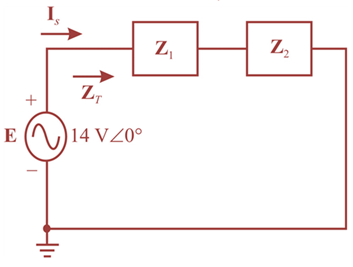
In the modified diagram,
Impedance
Impedance
Current
(c)
The current
Answer to Problem 1P
Explanation of Solution
Given:
The given circuit is:
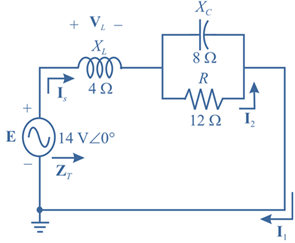
Calculation:
Let us modify the circuit as below to calculate the total impedance.
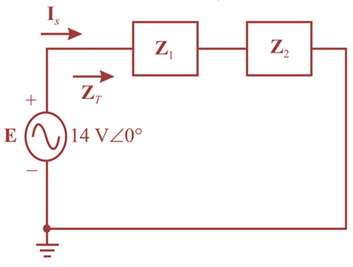
In the modified diagram,
Impedance
Impedance
Current
We can see from the circuit that,
(d)
The current
Answer to Problem 1P
Explanation of Solution
Given:
The given circuit is:
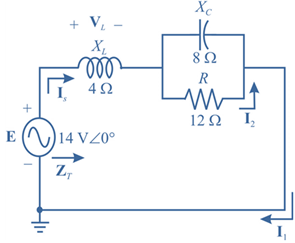
Calculation:
Let us modify the circuit as below to calculate the total impedance.
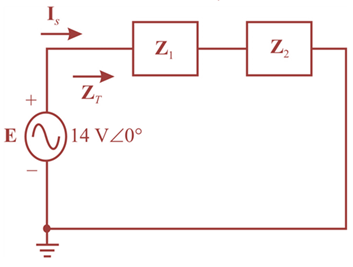
In the modified diagram,
Impedance
Impedance
Current
(e)
Voltage
Answer to Problem 1P
Explanation of Solution
Given:
The given circuit is:
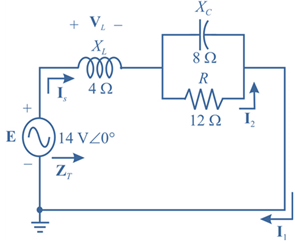
Calculation:
Let us modify the circuit as below to calculate the total impedance.
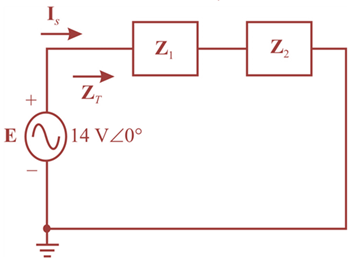
In the modified diagram,
Impedance
Impedance
Voltage
Want to see more full solutions like this?
Chapter 17 Solutions
Laboratory Manual for Introductory Circuit Analysis
Additional Engineering Textbook Solutions
Starting Out with Python (4th Edition)
SURVEY OF OPERATING SYSTEMS
Thermodynamics: An Engineering Approach
Database Concepts (8th Edition)
Electric Circuits. (11th Edition)
- P5. Although all fuses possess a thermal element that melts resulting in an open circuit, describe the difference between an "expulsion" and a "current limiting" fuse.arrow_forwardExpert only, don't use Artificial intelligence or screen shot it solvingarrow_forwardSolve this. find the initial conditions ic(0-) and vc(0-) the switch opens at t=0 so it's closed at t=0- dont copy the response from previous because it's wrong. please solve in great detail explaining everything step by step. now the way i thought about it is Getting millman voltage (1/3)-2 / (1/3)+(1/2) and it's the same as Vc as both are nodal voltages but i wasn't sure if correct. because i didnt take into consideration all voltages (Vc here) even though it's the same so i'm quite confused. please explain to me if i'm correct and if not tell me why and where my thinking was flawed. thank youarrow_forward
- 3. Consider the RL circuit with a constant voltage source shown in the diagram below. The values of the resistor, inductor, and input voltage are R = 100, L = 100 mH, and Vo = 12V, respectively. Vo - Ti(t) R w When the switch closes at time t = 0, the current begins to flow as a function of time. It follows from Kirchoff's voltage law that the current is described by the differential equation di(t) L dt + Ri(t) = Vo⋅arrow_forward4. Consider the RL circuit with a sinusoid voltage source shown in the diagram below. The values of the resistor, inductor, input voltage amplitude and frequency are R = 5, L = 50mH, and Vo = 10 V, respectively. The input voltage frequency w is variable. Assume that the circuit has reached steady state. Voejwt + ↑i(t) R سيد The input voltage can be described using the complex sinusoid function V(t) = Voejwt The current is given by a sinusoid with same the frequency was the input voltage, but a different magnitude and different phase. The physical voltage and current are obtained by taking the real part. In complex form, the current is given by i(t) Vo ejwt R1+jw/ The differential equation that describes the current follows from Kirchoff's voltage law, and is given by di(t) L + Ri(t) = Voejwt dtarrow_forward2. (4 marks) Use the real and imaginary parts of ĉejut, where ñ = a + jb = e³, to show that: c cos(wt) = acos(wt) – bsin(wt), csin(wt) = a sin(wt) + bcos(wt). Describe the relations between a, b, c, and o.arrow_forward
- Compute the thevenin equivalent between the two terminals a-b zeq and veq show all your steps and explain clearly what you did.arrow_forwardI need help with this problem and an explanation of the solution for the image described below. (Introduction to Signals and Systems)arrow_forwardI need help with this problem and an explanation of the solution for the image described below. (Introduction to Signals and Systems)arrow_forward
- Don't use ai to answer I will report you answerarrow_forwardconpute the thevenin equivalent between the terminals a and b Veq and Zeq note that the voltage source has 5e^j0 V the other values if not clear are -8j 8 20 and 5ohmsarrow_forward-calculate theoretical voltage and current values in Figure 1.3 and record them in Table 1.1. Calculate-all- voltage and current values as peak-to-peak. Table 1.1: Calculated Values of RC-Circuit ZTotale in (p-to-p)¤ VR-(p-to-p)¤ Vc-(p-to-p)¤ R(2) X-(2) mag (mA) angled mag (V) angled mag-(V) angle Freq. (Hz) X (N)- ρα ρα 500x 4000x ρα ρα ρα ρα ρα ρα ρα ραarrow_forward
 Power System Analysis and Design (MindTap Course ...Electrical EngineeringISBN:9781305632134Author:J. Duncan Glover, Thomas Overbye, Mulukutla S. SarmaPublisher:Cengage Learning
Power System Analysis and Design (MindTap Course ...Electrical EngineeringISBN:9781305632134Author:J. Duncan Glover, Thomas Overbye, Mulukutla S. SarmaPublisher:Cengage Learning Electricity for Refrigeration, Heating, and Air C...Mechanical EngineeringISBN:9781337399128Author:Russell E. SmithPublisher:Cengage Learning
Electricity for Refrigeration, Heating, and Air C...Mechanical EngineeringISBN:9781337399128Author:Russell E. SmithPublisher:Cengage Learning

